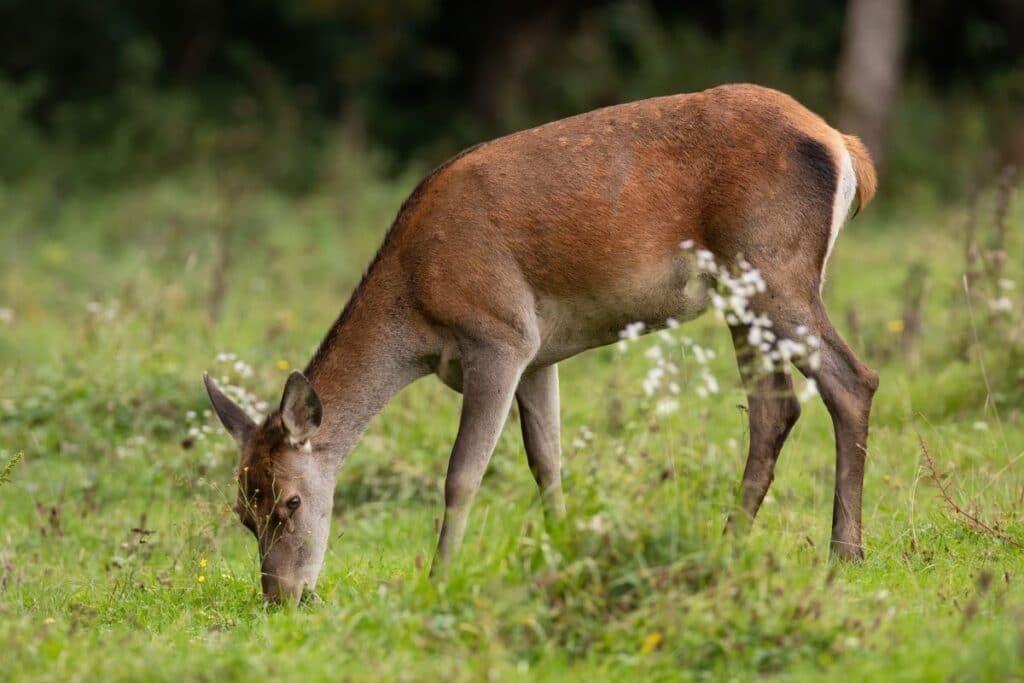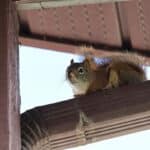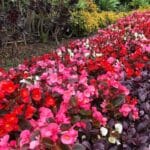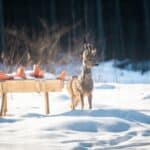Are you curious about what to feed deer in the backyard?
While some people might want to grow deer repellent flowers to keep these animals out of the garden, others might want to learn how to attract deer to their yard.
Giving food to deer in your backyard is a great way to make them feel at home and keep them away from your plants. You can either put out food specifically for deer or simply let them eat from your garden.
By knowing what types of food deer like, you can provide them with the best possible diet and keep them healthy.
Should You Feed Deer in Your Backyard?
As the days grow shorter and the temperature begins to drop, many of us start to think about ways to help the animals that will be spending the winter in our backyard. One popular method is to put out a feeder filled with corn or other grains. However, is this really the best way to help our furry friends?
Is it Illegal to Feed Deer in Your Yard?
Many state and local governments have enacted laws that prohibit people from feeding deer. However, these local laws are not always strictly enforced, and it is still fairly common for people to feed deer in their yards.
Some states have laws at the statewide level, including Rhode Island, New Hampshire, New York, Vermont, and others. Some laws apply to any feed site and age group, while others are focused only on baby whitetail deer versus adult deer.
Why are there laws? Most of the time, it has to do with interfering with the natural selection process, as the deer become overly reliant on food (the fawn stage is an especially critical time, hence the baby deer laws mentioned above).
However, some states also have laws in place due to chronic wasting disease, a communicable disease that can also affect humans.
While there may be some benefits to doing so, such as providing a food source for deer during harsh winters, it is ultimately best to avoid feeding them.
Not only is it illegal in many areas, but it can also lead to more problems down the road. When deer become accustomed to being fed by humans, they often lose their natural fear of people. This can lead to aggressive behavior, and in some cases, deer have even been known to attack people who try to stop them from getting food.
For these reasons, it is best to leave the deer alone and let them fend for themselves.
What is the Best Thing to Feed Deer?
Are you hoping to attract deer to your lawn with some food? Feeding deer is an inexpensive way to attract deer, but you need to think about their unique needs when introducing a new food source.
Here are some deer food ideas to consider depending on the time of year.
What to Feed Wild Deer in Summer and Spring
As the warm summer months approach, you may find yourself wondering what to feed wild deer.
While it is important to provide adequate nutrition for these animals, it is also important to be aware of the potential problems that can arise from overfeeding. In general, deer need a diet that is high in fiber and low in protein.
This can be achieved by feeding them a variety of foods, such as grasses, shrubs, and leaves. During the summer months, you can also supplement their diet with fruits and vegetables. However, it is important to avoid feeding them corn, as this can cause health problems if fed in excess.
The best way to feed deer is to let them browse naturally on vegetation, especially in the summer. This can help prevent them from becoming overly dependent on you for food. Natural plants are better for a deer’s stomach and you aren’t limited just to trees like apples.
Deer also love things like hickory nuts, cereal grains, honey locust trees, yellow birch, and so on.
By following these guidelines, you can ensure that your deer stay healthy and well-nourished throughout the summer and spring months.
What to Feed Deer in Fall
As the weather gets colder and the days get shorter, deer begin to prepare for winter. They do this by eating more food to build up their fat reserves, which will help them stay warm and give them energy to survive the winter months.
But what should you feed deer in fall?
The answer depends on what type of food is available in your area. In general, deer prefer foods that are high in carbohydrates, such as acorns.
However, they will also eat other types of plants, such as grasses and shrubs. If you live in an area where there are not many trees or other plants, you can supplement their diet with hay or other food sources, but again, moderation is key.
What Can You Feed Deer in Backyard During Winter
When it comes to feeding deer in the backyard during winter, there are a few key factors to keep in mind.
First, you’ll need to choose an appropriate food source that provides plenty of important nutrients for deer.
This can include things like corn, fruit and nuts, which will provide them with the energy they need to stay warm during the cold months. In addition, it’s important to think about where you’ll be setting up your deer feeder.
For best results, try to locate it somewhere sheltered and out of the wind, as this will help ensure that your deer don’t get too cold or risk developing frostbite from exposure.
Finally, make it a regular habit to check your feeder periodically to make sure that nothing has been spoiled or might inadvertently harm the deer. With these steps in mind, you’ll be able to successfully help support your local deer population through the winter season and beyond.
Can You Feed Deer Carrots?
At first glance, the idea of feeding deer carrots might seem a bit strange. After all, carrots are usually thought of as a human food; we eat them to help maintain healthy skin and teeth, improve our vision, and boost our immune system.
But it turns out that deer can actually benefit from eating carrots too! Carrots are rich in nutrients like vitamin A and minerals like calcium, both of which are essential for supporting healthy skin and a strong skeletal system.
Just don’t over do it. Deer are natural foragers, and overfeeding them with carrots or other human foods can cause them to become malnourished.
Tips for Feeding Deer
Deer are some of the most beautiful creatures in North America. They’re also a popular game animal, which means that many people take up hunting deer each year. If you’re thinking about feeding deer on your property, there are a few things you should keep in mind.
Do it Slowly
First, it’s important to do it slowly. Deer are shy by nature, and they may be afraid of sudden changes in their environment. If you start by leaving out a small amount of food, and gradually increase the amount over time, the deer will be more likely to accept it. This can also help them avoid digestive upset that might occur by the sudden change in diet.
Purchase a Formulated Mixture or the Right Foods
Second, you need to purchase the right mixture of foods, or choose foods that deer eat. Deer pellets, for example, are very popular choices.
Do deer eat breed? Yes, but feeding bread is a bad idea and can do more harm than good. This is not a typical deer feed and it’s highly acidic for a deer as well.
Don’t feed foods like corn, bread, barley, alfalfa, or hay – while small amounts of corn, alfalfa, and hay are fine in moderation, too much can lead to digestive problems or malnutrition.
Cut Down Branches
In the winter, food is scarce for deer. One way to help them out is by cutting down some branches and leaving them where the deer can reach them. The extra food will help the deer get through the winter and might even help them avoid getting hit by a car. If you have ever seen a deer in your headlights, you know how difficult it is for them to see cars coming. By providing them with extra food, you can help keep them safe as well.
Know the Right Timing – Winter is Best
Winter is the best time to feed deer in your backyard because natural food sources are scarce. If you start feeding them in the spring or summer, they may become dependent on you for food and lose their natural fear of humans.
Don’t Suddenly Stop
Timing and consistency are essential when you give food to deer in your backyard. If you suddenly stop feeding your deer, they may develop unhealthy or aggressive behaviors as a result.
Instead, it is important to slowly decrease the amount of food that you provide over time, so that your deer get used to adjusting to changes in their diet gradually.
This will make the feed transition both easier and safer for both you and the deer, as they will be less likely to exhibit unwanted behavior while they are coping with any sudden changes. So if you are looking to provide food for deer on your property, be sure to keep this tip in mind so that your herd stays healthy and safe.
Consider a Store Bought Deer Food
Another tip is to consider using a store bought deer food. These deer food mixtures are generally designed for deer hunting but can also be used on feeding sties that you’re using simply for watching deer.
These are foods that deer love to eat and they typically have a higher nutritional value than any other primary food source.
Choose the Right Location
There is no single “best” location for giving food to deer in your backyard. Instead, the ideal spot will depend on a number of different factors, including the size of your property and the types of feed you plan to offer.
For example, if you have a large property with plenty of open space, you might want to set up a feeder somewhere in the middle – this will give deer enough room to move around without feeling crowded or too exposed.
Alternatively, if you are feeding more limited quantities of deer food, it may be best to set your deer feeder closer to the edge of your property, so that browsing deer will be less likely to venture onto neighboring land.
Ultimately, the most important thing is to choose a spot that feels safe and accessible for the deer in your area. With careful consideration and some trial and error, you can find just the right location for keeping your local deer healthy and happy.
Improve the Year Round Habitat
Another tip for feeding deer? Make it your long-term goal to improve the natural habitat for deer rather than just feeding out formulated feed all the time in the feeder. By improving the environment you will make it easier for deer to find the nutrition they need in their own environment.
Add Mineral Blocks
An important thing to keep in ind is that deer need specially formulated mineral blocks to stay healthy.
While this obviously is not necessary in the wild, adding a new food source like hay can throw a deer’s diet off balance. Therefore, if you’re going to feed the deer corn or other food with a high starch content, make sure you add mineral.
Leave mineral blocks scattered wherever you plant to feed your hungry deer.
What is the Cheapest Thing to Feed Deer?
One of the cheapest things you can feed deer is actually corn.
This is because corn is a very cheap and readily available commodity. In addition, deer love to eat corn, so it makes an excellent choice for those who are looking to provide them with a nutritious meal. That said, corn isn’t always the best for the health of deer or for the deer’s digestive system, as explained above.
Another cheap option for feeding deer is hay. Hay is also relatively inexpensive and can be easily sourced from local farmers or online retailers. Deer will also enjoy eating hay, making it another great option for those looking to provide them with a healthy and affordable meal.
Another option? Organic oats. These shouldn’t be fed in large quantities, as they can lead to an overdependence (and don’t feed Quaker oats – we’re talking oats specifically for deer) but can be a good source of nutrients.
Remember to only feed any of these in moderation – you don’t want to overdo it.
Advantages and Disadvantages of Feeding Deer
There are a few things to consider before deciding whether or not to feed deer in your backyard.
First, it is important to remember that deer are wild animals, not pets. While they may seem tame and harmless, they can still pose a serious threat to both people and property. If you choose to feed them, it is important to do so in a way that minimizes the risk of injury or damage.
Second, keep in mind that feeding deer can alter their natural behavior. They may become less afraid of humans and more likely to venture into neighborhoods and yards in search of food. This can lead to increased conflict with people and property damage. Finally, remember that deer are capable of finding their own food. In most cases, they will not need our help to get through the winter months.
So, should you feed white tailed deer in your backyard? The answer depends on your individual situation.
If you are feeding the deer to keep them away from your woody plants, like your apple trees and shrubs, then it makes sense to keep doing so. However, just be mindful of the fact that deer are wild animals and you don’t want them to get too reliant on supplemental feed.
What Should You Not Feed Deer?
Although some people may think that feeding deer is a good way to attract them to their property and keep them happy, this is actually not the case. Feeding deer too much of any type of food can cause them to develop unhealthy habits.
Bread and Barley
Unfortunately, many people make the mistake of feeding deer bread and barley. While these foods may seem harmless, they can actually be very harmful to deer.
Bread is full of carbohydrates and sugars that can upset a deer’s delicate digestive system, while barley can contain high levels of toxins that can buildup in a deer’s system and cause serious health problems.
Too Much Corn, Hay, or Alfalfa Hay
While small amounts are fine in moderation, feeding deer too much of a food like corn or other hay can actually have negative consequences for these beautiful and majestic animals. You’ll make them overly reliant on your manufactured deer food and when it comes time for colder weather, their fat reserves might not be what they should without your artificial food supply.
For one thing, eating a diet that is too high in corn or hay can lead to serious digestive problems, including constipation and gas. Hay and alfalfa can also lead to bloating when fed in excess, particularly when other foods are scarce.
Attract Deer and Keep Them Healthy With These Deer Food Ideas!
If you’re looking for ways to help your deer population thrive, try implementing some of these tips. By planting the right food and providing a safe space for them to live, you can create an environment that will bring these beautiful creatures into your backyard.
See more:
*image by JakubMrocek/depositphotos







